|
I recently had the rare opportunity to watch the advanced girls' class at one of America's premiere ballet schools. A dear friend had made a generous donation and, being a fundamentally private person, she had declined the usual invitations to attend parties with donors and social climbers. When the ballet staff asked her if there was something else she might like to see vis-à-vis the school and company, she posed the question to me, and I enthusiastically suggested we attend this class.
My friend has only recently become a dévotée of classical ballet but she has been profoundly moved by her impressions. She notes and describes in detail the effect of the architecture of the theatres, the quality of the sound; sometimes a full orchestra, sometimes recorded collages of electronic noise; the range of choreographic styles, the sets and costumes, and, of course, those most celestial of all beings, the dancers themselves. Given that I've spent my entire life around the art form, it is a distinct and growing pleasure to spend time with her as she describes her impressions and opinions and asks penetrating questions. She evokes in me what the Buddhist teacher Shunryu Suzuki-roshi called "beginner's mind." She gives me the great gift of allowing me to see things as if for the first time. As we entered the dance studio for class that morning, she asked if ballet class was always the same or if each day it was different.
Anyone who has participated in the high ritual of an advanced ballet class would have registered the paradox in the answer to that question. Ballet class is a codified practice, similar throughout the world, but never, ever the same from one day to the next. It begins with an almost soporific series of deepening knee bends, performed with one hand lightly resting on the barre, and ends with a complicated explosion of full-body movements, a choreographed series the teacher has prepared the dancers to perform by layering preparatory exercises throughout the passing minutes of class.
This layering of technical and stylistic elements is not only fundamental to dance class, it defines the art form as we know it today. The history of ballet is the story of how a tradition was created and carried forward over the past four hundred years, without a common system of notation or method for recording it, by people standing in rooms together physically demonstrating and describing ideas about movement, feeling, musicality and character.
"Apollo's Angels, A History of Ballet" by Jennifer Homans (Random House, New York, 2010) is a remarkable work of scholarship. It is also a triumph of putting into words the indescribable and debatable, the ephemeral and disputable, the summing up and the breaking down of a history so personal to anyone who has been pivotal in its centuries-long development. The book is a brave act of paying homage and honoring a subject so vast and yet insolated, it seems almost like a betrayal of its very nature to describe it in linear form.
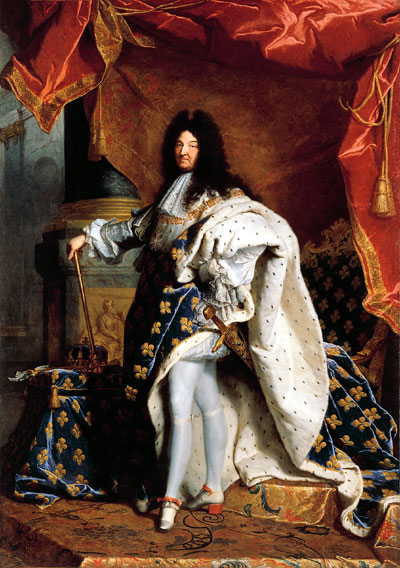 |
Catherine de Medici's sons, Charles IX and Henri III, shared her enthusiasm for the allegorical performances and ceremonial processions that originated in Italy and depicted ideas from Catholicism and chivalry. In spite of the brutality of 16th century France before, during and after the reign of Charles IX, he founded the Académies de Poésie et de Musique. His motives were not purely aesthetic, however. As part of a larger political effort to calm the masses with a balm both lofty and visceral, the Academy played an important role as an incubator for the ideas eventually developed into performances. Precise in time and space, dance steps set to music were eventually coalesced into theatrical presentations laced with heavy doses of morality. The creators expressed a goal no less ambitious than delivering humanity closer to spiritual perfection. Initially performances took place in parks and other large venues devoid of formality. During Louis XIII's reign, the concept of a stage, elevated above the ground and framed by a proscenium, played a crucial part in the powerful seduction achieved by these works of illusion.
Louis XIII, great grandson of Catherine de Medici, himself enjoyed portraying such central characters as the Sun and Apollo in the productions of his time. However, it was Louis XIV, known eventually as the Sun King, who devoted himself to over twenty years of serious training with ballet master Pierre Beauchamps. During the Sun King's reign aristocratic social dance and theatrical spectacle were woven into the formal conventions and fundamental classical ballet vocabulary as we now know it. Drawings from this period depict the five basic foot positions, which are analogous to the major scale in Western classical music, that are still practiced in dance studios around the world today.
Ballet continued its evolution throughout the reign of Louis XIV and even more significantly after his death. After the Sun King's demise, in 1715, ballet spread to cities throughout Europe and its refined, courtly mannerisms became a target as a symbol of decadence and decline. From its early role as the choreography of social status and ambition, as ballet spread outside court life and across the continent, it synthesized and adapted more popular and down to earth movement styles. Social reformers shunned ballet for its aristocratic associations but this helped ease the way for its transition into a more popular form of entertainment. It also opened an opportunity for women to come out of their supporting roles and claim their 18th century positions as ballerinas and innovators. Ballet opened itself to influences less aristocratic and celestial and more common and grounded, including mime and acrobatics, circus arts and adaptations from theatre and operatic forms.
As the pendulum swung in the direction of female empowerment and the rise of the preeminence of the ballerina, social and political forces combined to create a backlash against male dancers. They were seen as effeminate and disgraceful and were shunned, if not banned, from the stage. Male roles were taken on by women dressed in male attire, en travesti. This legacy would be passed on in France until early in the twentieth century.
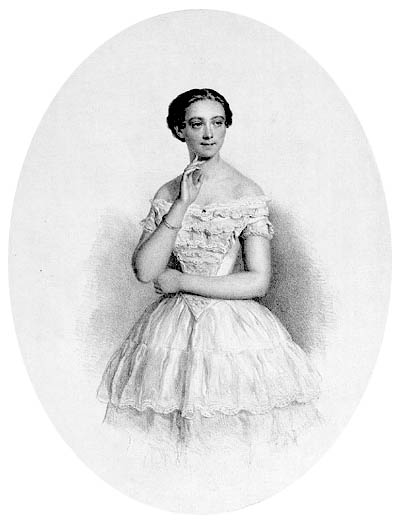 |
Ballet's first female celebrity, Marie Taglioni, who became synonymous with her role as La Sylphide, captured Europe's imagination with her ethereal presence, balanced on her toes in a white tulle skirt. Born in 1804 into an Italian family of dancers that excelled in acrobatics and the comic traditions of Commedia dell'Arte, her family also held strong traditional ties to the French noble traditions. In fact, her father, Filippo Taglioni, had travelled to Paris, along with his brother and sister, to study ballet with Jean-Francois Coulon and he held a brief position with the Paris Opera. At the time of Marie Taglioni's birth in Stockholm, her father held the position of ballet master at the Swedish court but he was to become ballet master in Vienna at the time of her debut. She was an extremely hard worker, not particularly physically gifted toward the rigors of dance technique at the time, so she adapted the movements and developed the muscularity necessary to accomplish her vision. Though comparatively heavy and muscular, she envisioned and created an athletic but graceful style of jumping that relied upon bent knees to ensure soft landings and no visible effort or strain. Though it had become fashionable in Italy to dance en pointe, Taglioni resisted this trend. She wore shoes, similar to those in vogue at the time, that included laces around the ankle, that enabled her to bear her weight somewhere between the ball and the tops of the toes—a strange and difficult feat that was one of her trademarks.
When Taglioni made her Paris debut, in 1827, critics embraced her graceful and elegant styled and thus proclaimed a new era. No longer would sweaty athletics be the norm, Taglioni had introduced what would become a highly influential style that reintegrated the aristocratic simplicity with a spiritual, ephemeral lightness and an iconoclastic femininity. If timing is everything, especially in dance, Taglioni's Paris debut, just three years before the revolution of 1830, enabled her to establish herself as a force majeure and continue evolving as an artist just as France reinvented itself and its Opera. Under the leadership of Louis-Phillippe, "King of the French," the Paris Opera was thrust, not without some continued support from the royal coffers, to the marketplace to determine its value. Taglioni's star power remained untarnished as she adapted her gifts to the extravagant operatic productions that would become legend.
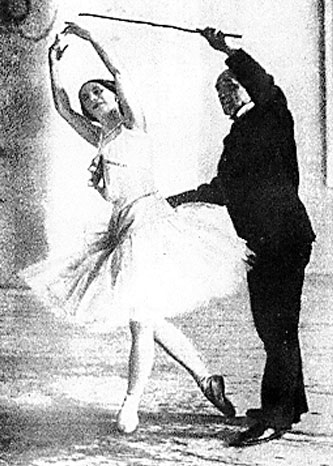 |
Taglioni was not the only Italian to achieve wide acclaim in Europe's ballet world. Enrico Cecchetti, born in Rome in 1850, would become one of the best known ballet teachers in European history. After mounting a production of an Italian ballet in St. Petersberg in 1887, the Russian authorities begged him to stay and named him principal dancer and second ballet master at the tsar's Imperial Theaters. He later toured the great Russian ballerina, Anna Pavlova, whose name is synonymous with the role Mikhail Fokine created for her, "The Dying Swan."
Fokine, the major choreographer of the new generation of early 20th century ballet, created the role of the dying swan as a reaction to what is to this day arguably the most well known of all ballet masterpieces, Marius Petipa's "Swan Lake." Fokine was inspired by his studies of art, music and theatre, which led him to question the standards and conventions that, in his view, had led to a stagnation and regimentation in ballet. In search of a unified aesthetic, driven not by convention but by stylistic integrity, he questioned the practice of parading groups of straight-backed dancers onto the stage only to configure them in rigid geometric patterns. In creating "The Dying Swan" for Pavlova, Fokine sought a lyrical meditation on death and he avoided any reference to the bravura technique that had infiltrated and taken over the art form. Rather than tell the anthropomorphic story of a swan who dies of a broken heart, Fokine inspired Pavlova to embody the qualities of a great and graceful creature who is slowly losing its once great strength.
Ironically, Imperial Russia was at this same time on the verge of losing its once great strength. Somehow sensing this, Fokine formed common cause with the impresario Sergei Diaghilev, to create the Ballet Russes. Diaghilev came from a progressive, provincial Russian family that celebrated literature and music. His grandparents had worked to end serfdom and his aunt was an early feminist who travelled in circles of reform-minded intellectuals and artists. A driven visionary who possessed a gift for belonging everywhere and nowhere, Diaghilev collaborated with an expanding group of what would become well-known artists to produce art exhibitions, opera and finally ballet productions that were fresh and daring. Too daring, in fact, for Russian audiences so he capitalized on the tsar's wish to establish cultural relations with France and took his shows on the road.
In the spring of 1909 Fokine, Diaghilev, Anna Pavlova, Tamara Karsavina, Vaslav Nijinsky, Leon Bakst, and Alexander Benois, along with a regiment of Russian ballet dancers on loan from the Maryinsky Imperial Theater in St. Petersberg, made their first appearance in Paris. Within two years, most of these artists and many more would cut their ties to the Maryinsky and form the Ballets Russes. In an odd twist, what the Parisians wanted to see was Russian ballet but Russian ballet did not truly exist. The Russians had created ballet in the image of the French. Diaghilev's instincts were so profound, and his abilities as an impresario so vast, he summoned a "Russian ballet" to quench the Parisian's thirst. Set to the music of a young and as-yet unknown composer, Igor Stravinsky, "The Firebird," was based on both Russian folk tales and music. Tamara Karsavina and Mikhail Fokine danced the lead roles of the firebird and the tsarevich. Costumed in oriental fabrics, she wore a feathered headdress and he sported a jeweled crown. Flowing out of the success of "The Firebird," Fokine created his lavish "Scheherazade" which also featured scantily clad dancers, including Vaslav Nijinsky, performing choreography at once rooted in French tradition and freed from it.
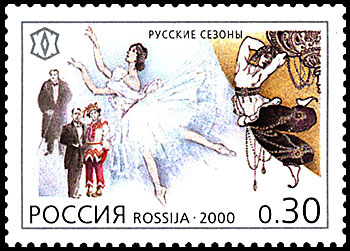 |
After the French had scorned and ridiculed male dancers for over a century, Nijinksy created a sensation with his androgynous, moody, self-absorbed performances. Similar to Maria Taglioni, Nijinsky had an unusual body and had to work extremely hard to achieve the fluidity and pliability he sought for his performances. Diaghilev and Nijinsky were lovers and Diaghilev had taken an early and profound in interest in every aspect of his education including not only his dancing but his education in visual art and music. Nijinsky, too, was a visionary who drove himself to not only create a unique dance style that rejected the static poses and flattering tricks popular at the time, he also became a choreographer of renown.
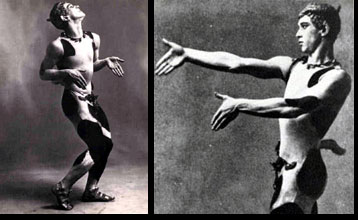 |
Nijinsky's "L'après-midi d'un faune" premiered in 1912 to music by Claude Debussy. Its animalistic movement vocabulary and blatant sexuality was a startling departure from the lavish and sensual works presented earlier by Ballets Russes. However, the work that followed, "Le Sacre du Printemps," with startlingly percussive and dissonant music by Stravinsky, made even "Faune" seem tame. Nijinsky and Stravinsky collaborated on the most controversial and incomprehensible work ever seen in Paris. Receiving only eight performances, the work's reputation would resonate even nearly one hundred years later when it was revived from photos. Dancers were hunched, bent and quivering, then suddenly they formed circles of furious movement, compulsively rhythmic yet wild and jarring. There was no narrative, almost no set, no individual self-expression, none of the usual symbols and signals of a ballet. Instead it was a repetitive ritual of rhythm of movement, both rational and raw.
The first decade of the twentieth century witnessed ruptures from the past in the fields of science and psychology but perhaps most vividly in the visual arts. The emergence of Cubism, led by Pablo Picasso and others closely allied with him, drew from folk traditions, primitivism and bold subjects previously shunned in fine art. Diaghilev and the Ballets Russes, Nijinsky, Stravinsky and Debussy added to the ruckus; their work was at once tolerated and rejected by Parisian society. Both Auguste Rodin and Marcel Proust were staunch supporters of Nijinsky and Ballets Russes. Performances sold-out even when prices were doubled as the controversies grew.
When the first world war broke out the Ballets Russes disbanded. Some of its members, such as Karsavina and Fokine returned to Russia, after spending a few fortunate years in Scandinavia during the Russian Revolution. Nijinsky and Diaghilev's relationship ruptured and Nijinsky married a Hungarian woman. His attempts at a solo career were disastrous and by 1920 he was institutionalized for mental illness; he would die in 1950 having never recovered. Counter- intuitively the Revolution did not mean an end to government-sponsored ballet in Russia. Lenin appointed a commissar of education in charge of cultural affairs who saw spiritual development of the people as his duty and ballet as one of his means. In addition to revivals of "The Sleeping Beauty," "Raymonda" and other Petipa ballets, the state commissioned "tractor ballets" which featured shiny shovels and troves of glorified workers creating the new state.
A former dancer named Fedor Lopukhov, who had toured the United States with Anna Pavlova, was named head of the Maryinsky Imperial Theatre which would soon to be renamed the Kirov Ballet (and has only recently been renamed Maryinsky). Lopukhov added his own, more abstract, choreography to the Maryinsky repertoire and one of his works featured a young dancer named Georgi Balanchivadze (George Balanchine).
Balanchine was thirteen at the time of the Revolution. He began his education on one side of the divide and finished it on the other. Intelligent, curious and aesthetically gifted, he immersed himself in dance, music and art until he felt the reins of the Soviet regime tightening around him and stifling his creativity. 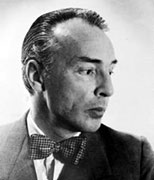 When, in 1924, a group of dancers organized a tour abroad, sanctioned by the state to promote Soviet culture, he made the decision to leave the homeland and join them. Once Balanchine united with Diaghilev in Paris the two joined forces and Balanchine began to create work for the Ballets Russes which had remade itself once again. They worked together until Diaghilev's death in Venice in 1924. When, in 1924, a group of dancers organized a tour abroad, sanctioned by the state to promote Soviet culture, he made the decision to leave the homeland and join them. Once Balanchine united with Diaghilev in Paris the two joined forces and Balanchine began to create work for the Ballets Russes which had remade itself once again. They worked together until Diaghilev's death in Venice in 1924.
As Diaghilev had revolutionized dance in Europe, George Balanchine would in the United States. In her exhaustive "Apollo's Angels: A History of Ballet," Homans writes: "…twentieth century French, British, and American ballet owe their existence to Diaghilev…"
I will depart from the history here because the rest is so well known. Just one last anecdote. In the mid-1970s a young dance student named Jennifer Homans stood at the barre in George Balanchine's School of American Ballet. Like those teenaged dancers my friend and I watched last month, and like so many before and after her, she began with her pliés and, under the strict observation of a teacher who had come from the same Russian tradition as Balanchine, worked her way through the progression of exercises until she found herself leaving the floor and reaching for the celestial heights of perfection. Having lived the life of one of Apollo's angels, she has written an exhaustive and passionate tribute to the four-hundred year history of ballet.
|

